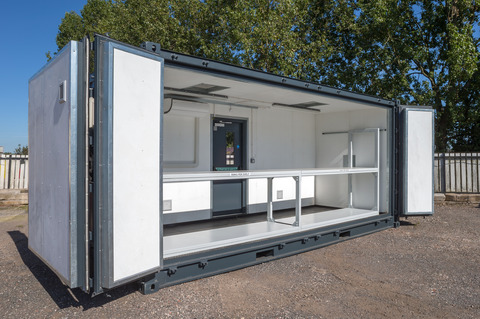Purpose-built units ensure risk limitation
14 Dec 2022

Purpose-built units reduce the risks with hazardous process development and remote R&D scaling says S Jones Containers’ Andrew Capella who lists key benefits and requirements to bear in mind...
Fast-paced development and testing is essential to the commercial success of new processes. While securing the necessary planning permissions and implementing safety modifications or extensions of existing facilities can take years, a containerised solution can be developed offsite and installed within just a few months, without the need for planning permission.
In some cases, inherent risk within the process itself means that it can’t be effectively contained on site. An offsite construction can enable riskier processes to be operated externally to minimise the number of people in contact with the hazardous process.
An option that is becoming increasingly popular is contactless or remote process development and management. In some cases, this could include splitting the container, with one-side offering a protective environment for operators and another housing the necessary chemicals and equipment. A gas tight door can also be installed to offer added protection. Alternatively, engineering firms are keeping the entire process in a self-contained environment managed remotely from the main site.
Insure against danger
The need to house process development away from main sites is particularly important where there is a risk of fire or explosion, which could invalidate existing insurance agreements. A self-contained unit prevents damage to wider facilities and people.
Ensuring a non-reactive environment is paramount when dealing with hazardous chemicals. Using specialist coatings and materials a self-contained unit can be specifically developed around the process that will prevent adverse reactions. There are a number of chemically resistant materials such as Plastisol coated steel, oriented strand board (OSB/3) and hygienic PVC which can be used for the internal structure and insulation of a purpose-built process development site that will ensure the right testing and development conditions.
Consistency counts
One of the greatest dangers for a lot of chemicals is destabilisation due to rising or falling temperatures. The benefit of a self-contained unit is that the heating and cooling requirement can be developed specifically for the process at hand.
Gas leakages or gas explosions are one of the most commonly cited risks in new process development. To address this, additional vents can be installed onto units to evacuate toxic fumes quickly and effectively in the event of a leak or build-up of toxic gasses. In the case of fire, a ventilation system that can automatically shut down is essential.
Go anywhere
One of the added benefits of using a container for process development and implementation is that it can be transported to the point of need. We have created process engineering and testing labs that are transported around the UK and across the world, helping to unlock new markets and applications for advanced engineering systems.
Push boundaries
In some cases, engineering firms and research organisations may want to understand exactly what does go wrong and under what circumstances with a given process. One of our latest applications has been to create a site for battery abuse testing, pushing the chemical make up to the limit to identify the technologies tolerances. With extreme R&D and testing like this, there will be a catastrophic incident and it’s about ensuring the environment is as robust and safe as possible to deliver this. A lot of the time this will require the use of fire and sprinkler system repression technology to help contain the damage.
Risks of explosion, fire or toxic gas emissions can often mean existing facilities are either impractical or too costly to convert. Whether working to solve the world’s energy crisis, developing and testing the latest lithium-ion battery technology or creating and scaling new industrial processes, self-contained research labs are often the quickest, safest and most effective way of enabling process development.
Andrew Capella is industrial conversion specialist at S Jones Containers

